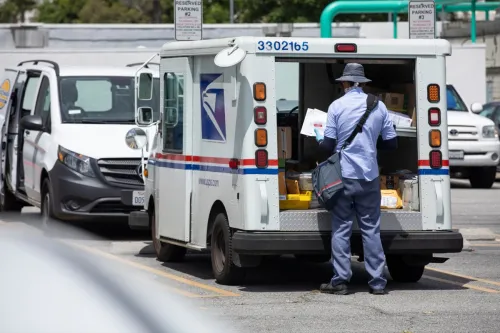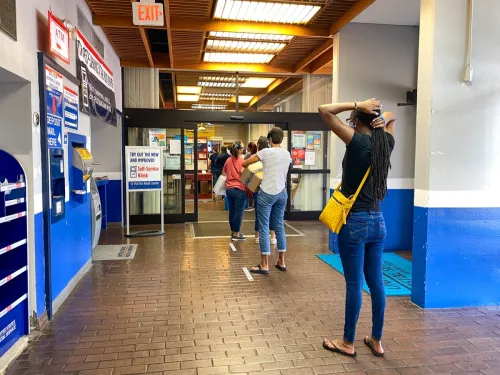USPS Just Raised Prices Again—And It’s Already Planning the Next Price Hike

It seems like we’re having to pay more for everything these days—and that includes our mail. The U.S. Postal Service (USPS) has been struggling financially for years now. To change course, the agency unveiled its Delivering for America (DFA) initiative in 2021 with the goal of reaching financial sustainability again within the next 10 years. And unfortunately for us, part of the plan includes price hikes for customers. The USPS just raised its prices on Jan. 22—and it’s already planning the next price hike. Read on to find out what you should be prepared for.
READ THIS NEXT: USPS Is Getting Rid of This Permanently, as of Jan. 31.
The Postal Service started raising prices in 2021.

Just two months after introducing its DFA plan, the USPS had already announced plans to raise prices. In May 2021, the agency said that it had filed notice with the Postal Regulatory Commission (PRC) to “raise overall Market Dominant product and service prices by approximately 6.9 percent” later that year. The PRC approved the price hike, and it kicked in officially on Aug. 29, 2021.
Since then, customers have seen mailing costs climb again and again. In July 2022, the Postal Service raised its First-Class Mail prices by approximately 6.5 percent. Then just a few months later, the agency increased prices yet again: On Oct. 2, “a temporary price adjustment for key package products for the 2022 peak holiday season” went into effect. “This temporary rate adjustment is similar to ones in past years that help cover extra handling costs to ensure a successful peak season,” the USPS explained.
Now, however, the agency is back to more permanent price hikes.
The most recent price change just went into effect.

The temporary price hike for the 2022 holiday season expired on Jan. 22, but it coincided with a more permanent change. Back in October, the Postal Service announced that it had filed plans with the PRC for “new prices for 2023.” The commission approved the new rates, which went into effect on Jan. 22 and increased First-Class Mail prices by approximately 4.2 percent.
The USPS also raised prices for P.O. Box rentals and shipping services that same day. “As operating expenses continue to rise, these price adjustments provide the Postal Service with much needed revenue to achieve the financial stability sought by its Delivering for America 10-year plan,” the agency said.
RELATED: For more up-to-date information, sign up for our daily newsletter.
USPS already has plans for its next price hike.

With the newest price increase, customers are now paying three to five cents more for mailing essentials like postcards, letters, and First-Class Forever stamps. And that’s likely not the last time we’ll see price hikes this year. Instead, officials say that customers should expect another increase this summer.
“The Postal Service expects that, in each subsequent year, it will implement price changes for all Market Dominant classes in January and July of such year,” the PRC said, per USA Today.
The USPS confirmed this timeline for price hikes in a Sept. 2021 press release. “Beginning Jan. 2023, Market Dominant price adjustments will occur twice a year, (e.g. Jan. 2023, July 2023, Jan. 2024, July 2024, etc.),” the agency said. “Market Dominant products include First-Class Mail (FCM), USPS Marketing Mail, Periodicals, Package Services, and Special Services.”
Postmaster DeJoy has defended the agency’s rising prices.

These regular price increases are starting to add up for USPS customers. For example, stamp prices are now about 15 percent more expensive than what they were prior to 2021, and they have nearly doubled from the 33 cents they cost in 2000, Money magazine reported.
But Postmaster General Louis DeJoy has stood by the Postal Service’s soaring prices and made it clear that he has no plans to stop the hikes anytime soon.
“I believe we have been severely damaged by at least 10 years of a defective pricing model—which cannot be satisfied by one or two annual price increases—especially in this inflationary environment,” DeJoy said during a 2022 Postal Service Board of Governors meeting. “From my perspective, the mailing industry needs to be prepared for continued use of our authority to raise prices on market dominant products at an uncomfortable rate until such time as we have accomplished our objective of projecting a trajectory that shows us becoming self-sustaining—as required by law.”